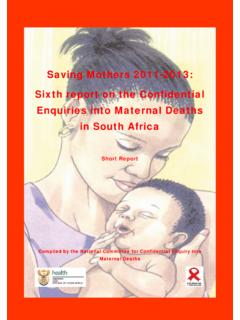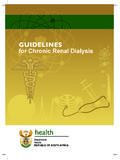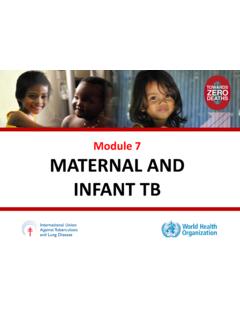Transcription of What is the impact of HIV on families? - WHO/Europe | Home
1 what is the impact of HIV on families? December 2005 ABSTRACT This Health Evidence Network (HEN) evidence report examines how HIV influences family lives and howfamilies deal with the disease. In the context of an increasing number of HIV positive people in Europe, the reporthighlights several policy considerations such as: promotion of primary and secondary HIV prevention with specific efforts directed at the group of people below 30 years of age; environmental changes likely to reduce the risk of HIV, such as policy changes and the reduction of poverty; and establishement of family-based services, possibly integrated into family planning, antenatal care andobstetric and child health services, aimed at the specific needs of living with HIV and HAART.
2 HEN, initiated and coordinated by the WHO Regional Office for Europe, is an information service for publichealth and health care decision-makers in the WHO European Region. Other interested parties might also benefit from HEN. This HEN evidence report is a commissioned work and the contents are the responsibility of the authors. They donot necessarily reflect the official policies of WHO/Europe . The reports were subjected to international review,managed by the HEN team. When referencing this report, please use the following attribution: van Empelen P (2005) what is the impact of HIV on families? Copenhagen, WHO Regional Office for Europe (Health Evidence Network report; , accessed 01 December 2005).
3 Keywords HIV INFECTIONS FAMILY psychology ADAPTATION, PSYCHOLOGICAL CAREGIVERS FAMILY THERAPY HEALTH PROMOTION META-ANALYSIS EUROPE Address requests about publications of the WHO Regional Office to: by e-mail (for copies of publications) (for permission to reproduce them) (for permission to translate them) by post Publications WHO Regional Office for Europe Scherfigsvej 8 DK-2100 Copenhagen , Denmark World Health Organization 2005 All rights reserved.
4 The Regional Office for Europe of the World Health Organization welcomes requests for permission to reproduce or translate its publications, in part or in full. The designations employed and the presentation of the material in this publication do not imply the expression of any opinion whatsoever on the part of the World Health Organization concerning the legal status of any country, territory, city or area or of its authorities, or concerning the delimitation of its frontiers or boundaries. Where the designation country or area appears in the headings of tables, it covers countries, territories, cities, or areas. Dotted lines on maps represent approximate border lines for which there may not yet be full agreement.
5 The mention of specific companies or of certain manufacturers products does not imply that they are endorsed or recommended by the World Health Organization in preference to others of a similar nature that are not mentioned. Errors and omissions excepted, the names of proprietary products are distinguished by initial capital letters. The World Health Organization does not warrant that the information contained in this publication is complete and correct and shall not be liable for any damages incurred as a result of its use. The views expressed by authors or editors do not necessarily represent the decisions or the stated policy of the World Health Organization. 2 what is the impact of HIV on families? WHO Regional Office for Europe s Health Evidence Network (HEN) December 2005 The 4 4 Policy Type of Pattern of HIV infection across HIV and Sources for this The physical, psychological and social impact of The role of the family as The impact of HIV on The impact of HIV on Current 19 Strength of Policy Annex 1: Annex 2: Evidence search 24 3 what is the impact of HIV on families?
6 WHO Regional Office for Europe s Health Evidence Network (HEN) December 2005 Summary The issue In Europe, the number of people infected with human immunodeficiency virus (HIV) is increasing. More infections of heterosexuals are appearing, and young people and women are becoming more vulnerable. For these people, the introduction of highly active antiretroviral therapy (HAART) now allows them to live longer with HIV. Also, since antiretroviral therapy has reduced the risk of mother-to-child transmission of the virus, infected men and women can consider parenting, and HIV-infected children are living into adolescence. This synthesis examines how HIV influences family lives and how families deal with the disease. Findings Human immunodeficiency virus has a large psychological, physical and social impact on infected individuals and their families.
7 Stigmatization worsens this impact : it hinders the prevention and treatment of HIV and hampers social support and HIV disclosure. The families most affected by HIV are characterized by low socioeconomic status, which includes such groups as drug users, migrants and asylum seekers. The risk of transmitting HIV, which includes that of mother-to-child transmission, increases when people are unaware of their HIV infection, when they do not disclose their HIV status, when they do not have access to effective treatment and HIV care, and when they do not have access to family planning advice that addresses the issue of HIV. The long-term aspects of living with HIV in the era of HAART need to be considered. New possibilities, such as parenting and care of children, need to be considered, and the difficulties in managing HAART (such as adhering to treatment, side-effects and optimal treatment regimen) need to be investigated further.
8 Also, the inequalities faced by those living with HIV, such as obtaining or maintaining employment and life assurance, need to be addressed. The psychological, physical and social needs of HIV-infected children and their parents need to be considered, especially the needs of HIV-infected children growing into adolescence and adulthood. Also, parents find it difficult to disclose the child s HIV status. Moreover, promoting HIV prevention among HIV-infected young people is important. For children orphaned by HIV, special care is needed to equip them for the future. Policy considerations Primary and secondary HIV prevention needs to be promoted, which means educating people about HIV, providing materials for its prevention, providing access to treatment and providing programmes that reduce both the short and long term physical, psychological and social harm it causes in adults and children.
9 Specific prevention efforts should be directed at the group of people below 30 years of age. Environmental changes likely to reduce the risk of HIV, such as policy changes and the reduction of poverty, should be encouraged. Policy changes should be directed at ensuring laws that protect the human rights of people infected with HIV, regardless of their cultural background or lifestyle, and at ensuring the institution of an active testing policy for HIV. Family-based services, possibly integrated into family planning, antenatal care and obstetric and child health services, need to be established, to provide assistance to couples affected by HIV and to address the specific needs of parents and their children all aimed at the specific needs of living with HIV and HAART.
10 4 what is the impact of HIV on families? WHO Regional Office for Europe s Health Evidence Network (HEN) December 2005 More research should be directed at the better understanding of the long-term side-effects of HAART, at ways to improve adherence, and at ways to improve treatment safety, such as drug treatment interruptions. Type of evidence This synthesis presents evidence based on a systematic review of (social) scientific and grey literature and uses all forms of studies, but mainly observational series. 5 what is the impact of HIV on families? WHO Regional Office for Europe s Health Evidence Network (HEN) December 2005 Contributors Author Pepijn van Empelen, PhD Department of Clinical and Health Psychology Leiden University PO Box 9555, 2300 RB Leiden, The Netherlands Tel: +31 (0)71 5273749, Fax: +31 (0)71 5274678, E-mail: Technical editor Professor Karen Facey, Health Evidence Network, WHO Regional Office for Europe Peer reviewer Dr Christiana N stlinger, Institute of Tropical Medicine, Department of Clinical Sciences, Belgium.
















